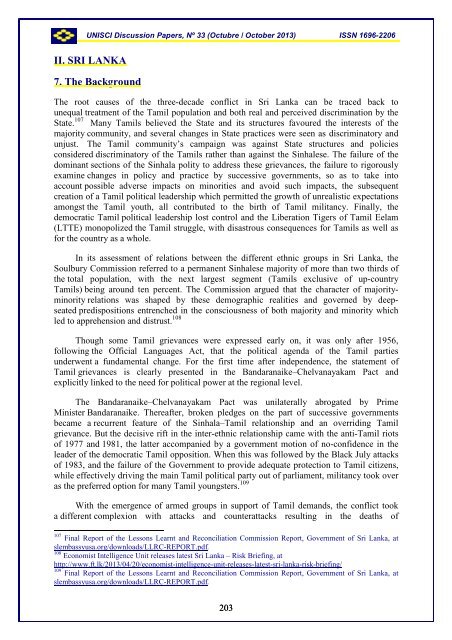UNISCI - Universidad Complutense de Madrid
UNISCI - Universidad Complutense de Madrid
UNISCI - Universidad Complutense de Madrid
Create successful ePaper yourself
Turn your PDF publications into a flip-book with our unique Google optimized e-Paper software.
<strong>UNISCI</strong> Discussion Papers, Nº 33 (Octubre / October 2013) ISSN 1696-2206II. SRI LANKA7. The BackgroundThe root causes of the three-<strong>de</strong>ca<strong>de</strong> conflict in Sri Lanka can be traced back tounequal treatment of the Tamil population and both real and perceived discrimination by theState. 107 Many Tamils believed the State and its structures favoured the interests of themajority community, and several changes in State practices were seen as discriminatory andunjust. The Tamil community’s campaign was against State structures and policiesconsi<strong>de</strong>red discriminatory of the Tamils rather than against the Sinhalese. The failure of thedominant sections of the Sinhala polity to address these grievances, the failure to rigorouslyexamine changes in policy and practice by successive governments, so as to take intoaccount possible adverse impacts on minorities and avoid such impacts, the subsequentcreation of a Tamil political lea<strong>de</strong>rship which permitted the growth of unrealistic expectationsamongst the Tamil youth, all contributed to the birth of Tamil militancy. Finally, the<strong>de</strong>mocratic Tamil political lea<strong>de</strong>rship lost control and the Liberation Tigers of Tamil Eelam(LTTE) monopolized the Tamil struggle, with disastrous consequences for Tamils as well asfor the country as a whole.In its assessment of relations between the different ethnic groups in Sri Lanka, theSoulbury Commission referred to a permanent Sinhalese majority of more than two thirds ofthe total population, with the next largest segment (Tamils exclusive of up-countryTamils) being around ten percent. The Commission argued that the character of majorityminorityrelations was shaped by these <strong>de</strong>mographic realities and governed by <strong>de</strong>epseatedpredispositions entrenched in the consciousness of both majority and minority whichled to apprehension and distrust. 108Though some Tamil grievances were expressed early on, it was only after 1956,following the Official Languages Act, that the political agenda of the Tamil partiesun<strong>de</strong>rwent a fundamental change. For the first time after in<strong>de</strong>pen<strong>de</strong>nce, the statement ofTamil grievances is clearly presented in the Bandaranaike–Chelvanayakam Pact an<strong>de</strong>xplicitly linked to the need for political power at the regional level.The Bandaranaike–Chelvanayakam Pact was unilaterally abrogated by PrimeMinister Bandaranaike. Thereafter, broken pledges on the part of successive governmentsbecame a recurrent feature of the Sinhala–Tamil relationship and an overriding Tamilgrievance. But the <strong>de</strong>cisive rift in the inter-ethnic relationship came with the anti-Tamil riotsof 1977 and 1981, the latter accompanied by a government motion of no-confi<strong>de</strong>nce in thelea<strong>de</strong>r of the <strong>de</strong>mocratic Tamil opposition. When this was followed by the Black July attacksof 1983, and the failure of the Government to provi<strong>de</strong> a<strong>de</strong>quate protection to Tamil citizens,while effectively driving the main Tamil political party out of parliament, militancy took overas the preferred option for many Tamil youngsters. 109With the emergence of armed groups in support of Tamil <strong>de</strong>mands, the conflict tooka different complexion with attacks and counterattacks resulting in the <strong>de</strong>aths of107 Final Report of the Lessons Learnt and Reconciliation Commission Report, Government of Sri Lanka, atslembassyusa.org/downloads/LLRC-REPORT.pdf.108 Economist Intelligence Unit releases latest Sri Lanka – Risk Briefing, athttp://www.ft.lk/2013/04/20/economist-intelligence-unit-releases-latest-sri-lanka-risk-briefing/109 Final Report of the Lessons Learnt and Reconciliation Commission Report, Government of Sri Lanka, atslembassyusa.org/downloads/LLRC-REPORT.pdf.203
















